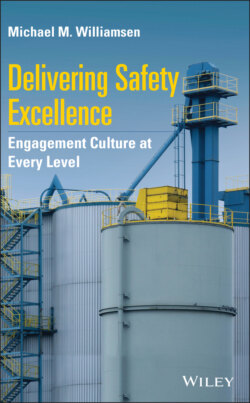Читать книгу Delivering Safety Excellence - Michael M. Williamsen - Страница 20
5 Weak Culture Miseries
ОглавлениеAaron thinks about his future with his struggling company as he wrestles with what kind of future awaits him. After all the frustrations, discussions, ups and downs, Aaron decides it is his turn to be completely committed. At this moment Aaron's decision means he needs to take responsibility for developing a strong safety department that can both serve and lead the needs of his company's safety, health and environmental issues. However, all of the above are not looking all that great at this moment in time. He considers the recent coaching he has received and how this can help him move forward with the daunting challenges that his commitment to stay, serve, and excel will require of himself and those who work with him.
Aaron's next gut check is not all that encouraging. The Doc talked to him about leaders, followers, and resisters. In a weak safety culture it seems: leaders go to more important jobs, followers follow them, resisters and poor performers are put in safety where they can be hidden. Indeed, this is Aaron's lot in the life as a safety manager in an organization which only gives lip service to safety. This too had been the Doc's experience with the Fortune 20 company trying to dig their way out of the poor safety culture hole.
Aaron pulls up his consultation notes and reflects on what the Doc refers to as a unit operation called excellent safety culture performance, but which safety societies often think of as one of a number of normal safety processes. As with any other unit operation/normal safety process, there is an ongoing dynamic of many moving parts:
Each of the number of individual process steps must be done well.
All these moving parts must fit together if an organization is to achieve anything that has a chance of putting an end to a culture of mediocrity.
Any attitude of “good enough” or “close enough” is a death knell to achieving anything in which people of the organization want to commit to delivering world‐class performance.
What are the necessary steps to achieve safety culture excellence? Aaron noted extreme shortfalls in: management commitment, leadership involvement for hourly and salaried personnel, training, engagement, near miss, etc. ad infinitum. But which one(s) do you lead with? There is just too much to do with not sufficient resources, and everything needs to be done now.
There is the additional complication that over the years a weak culture seems to reward poor performing salaried employees by not requiring much in the way of anything which even remotely approaches excellence. As a result, the status quo momentum of “good enough” drags down one part of the organization after another. This type of vicious negative cycle is especially true in a company like the one where Aaron works. Aaron faces daily frustrations as ER (Employee Relations department) sets hurdles that take forever for Aaron to overcome as he tries to resolve the poor performance of the few bad apples who drag down the overall performance of the entire group. So where to start? Aaron decides to take on a challenge required for his success. With this decision he commits himself to successfully navigating all the ER and interpersonal challenges required to shed himself of his worst bad apple person. If the safety department is to move forward this is Aaron's personal “must solve” challenge.
Thus, Aaron returns to his decision of a commitment to getting rid of the worst apple. He must take the lead in doing whatever it takes to resolve his personnel issue. ER cannot be an excuse for Aaron in this matter. If Aaron is to run the race set before him, then he must personally be successful in getting over the hurdles as they come up.
As this saga unfolds, in however long it takes, the second part of the weak safety culture strategy has Aaron beginning a process of mentoring the other few safety staff members in order to help them deliver better performance. Aaron plans out the needed steps for success. As a part of this improvement strategy he also decides how he will give them the needed personal appreciation/recognition for good performance as it occurs. Personal, frequent, sincere feedback for a job done well is a true asset in lifting the performance of an individual and an organization. Such reinforcing feedback is also a necessity for the team comprised of the various individuals who are keeping all the moving parts going in the correct directions. Aaron wishes he had been given this kind of reinforcing feedback, but no need to whine about past events. Therefore, he realizes that, “I must take responsibility for what I can do now to improve our lot. If it is to be, it is up to me; so suck it up buttercup. Here we go!”
And then a significant surprise occurs when his best trainer, who quit because of the worst apple, comes back and tells Aaron that if he can get rid of the bad apple he would like to come back and help the department to improve the company's safety performance.
